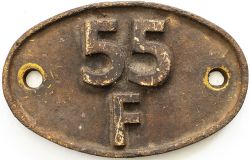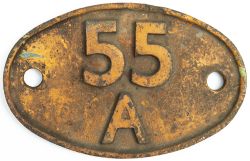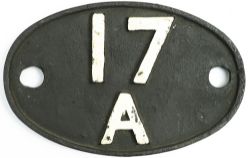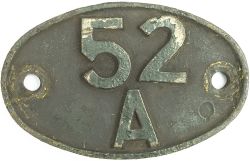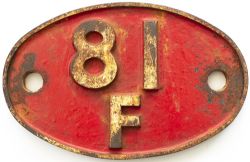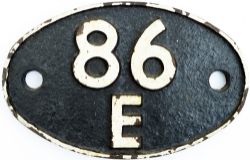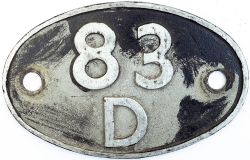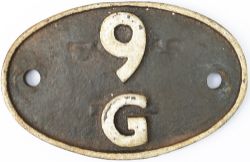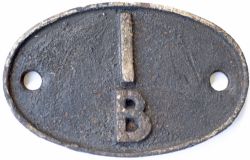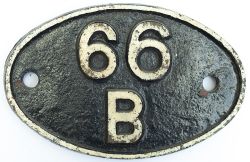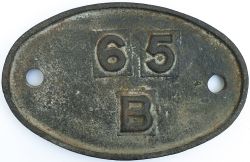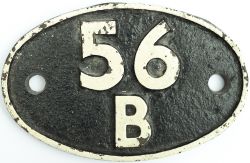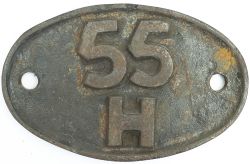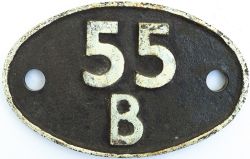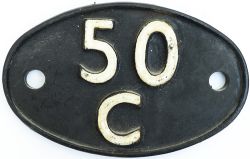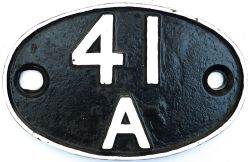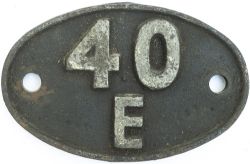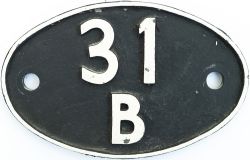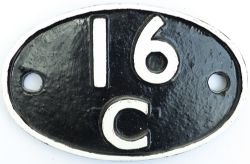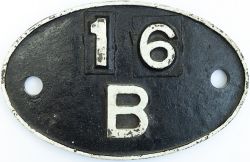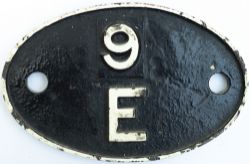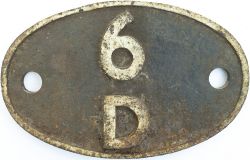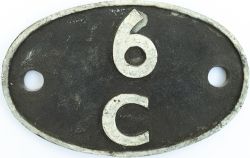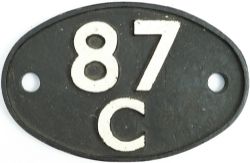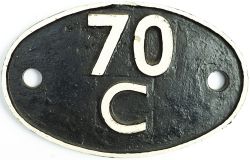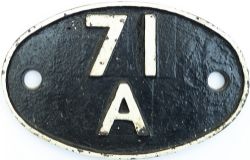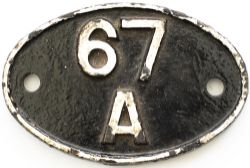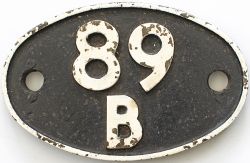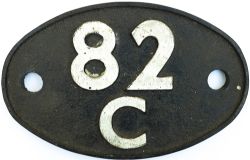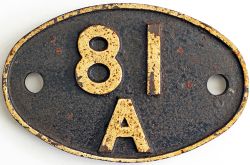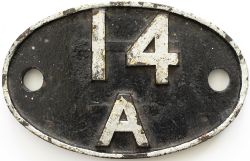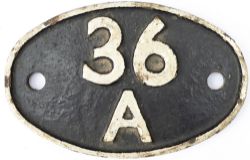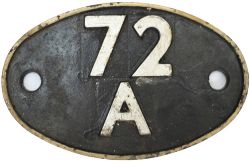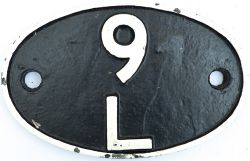You need to be registered and approved to bid at this auction.
Watch the auction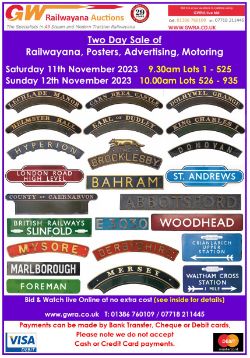
This is a Live Internet auction only
IF YOU LAUNCH THE LIVE BIDDING APP AND HAVE PROBLEMS VIEWING THE LIVE SALE, PLEASE DELETE YOUR EMAIL AND PASSWORD AND RE ENTER MANUALLY DO NOT USE AUTOFILL
If you have any issues trying to register please contact Auction Technology Directly as we haven’t got any access to your details.
support@auctiontechnologygroup.com
It is important that you sign up through our link not through the-saleroom.com directly as the point of sign up attracts different commissions.
|
Auction currency
|
GBP |
|
Accepted cards for registration
|
|
|
Accepted cards for payment
|
|
|
Other payment methods
|
Shedplate 55F From one of the Diesels allocated to Bradford Hammerton Street. In original yellow paint with plenty of brake dust.
Shedplate 55A Holbeck February 1957 to May 1973. In as removed condition with plenty of brake dust from one of the depots diesels which included class 45 Peaks. In as removed condition.
Shedplate 17A Derby 1935-September 1963. The former Midland HQ at Derby had a shed housing around 140 locos in the 1950s. By the time it lost this code it was down to just 40. White only restored the rest as removed.
Shedplate 52A Gateshead 1950-1973. This is one of the later cast iron versions that were fitted to some of the depot's Diesel locomotives. In as removed condition in BR green paint, you won't see a better example.
Shedplate 12A Carlisle Kingmoor 1935-1949 and February 1958-January 1968, also Carlisle Upperby 1950-February 1958. The ex CR shed at Kingmoor used this code twice. During its second spell as a LMR shed it had 120 locos allocated. Patriots, Royal Sco ts, Princess Royals, Coronations, Clans, and no fewer than 51 out of 55 Britannias were allocated here during this period. Ex LNWR shed Carlisle Upperby had around 80 locos in the 1950s, and it too had a star studded cast of Patriots, Jubilees, Royal Scots and Coronations. In restored condition.
Shedplate 18C Hasland 1935 to September 1963. This ex Midland Railway shed was home to 50 locos in the 1950s. This included 13 LMS Beyer Garratt 2-6-6-2s. It was recoded 16H and closed in September 1964.
Shedplate 81F Oxford 1950-January 1966. This ex GWR shed was home to 11 Halls and 4 Granges in its final year; and provided vital servicing facilities for visiting steam locos from all four post grouping companies. At its height it had an allocation of around 60 locos. Lightly cleaned with clear Swindon casting marks to rear and edge, accompanying plate is a hand written note confirming this was from 5012 Berry Pomeroy Castle and was acquired from Swindon.
Shedplate 86E Severn Tunnel Junction 1948 to October 1965 for steam. This ex GWR shed was home to around 75 locos in the 1950s. In lightly cleaned original condition with correct Swindon casting marks to rear and edge.
Aluminium shedplate 83D Plymouth Laira to September 1963. In lightly cleaned condition, these were fitted to the early Western Region hydraulics.
Shedplate 9G Northwich 1949-February 1958, then Gorton February 1958-June 1965. The ex CLC shed at Northwich housed 40 locos during this period, three of which were ex GCR 4-4-0 Directors. It was then recoded 8E in 1958. The ex GCR shed at Gorton was transferred from the ER 39A and all 110 of its charges carried the 9G code until closure in 1965. In lightly face restored condition.
Shedplate 1B Camden 1935-September 1963 to steam, January 1966 totally. In 1950 this ex LNWR shed was home to no fewer than sixteen Royal Scots and a similar number of Coronation pacifics in a total of 55 locos. By 1959 the overall total had fallen t o 40, and in its final few months of steam it still had seven Coronations on its books. This style of plate was also carried by the early Class 24 and Class 40 locos allocated here. In as removed condition.
Shedplate 84E Tyseley 1949-September 1963. This ex GWR depot had well over 100 locos on its books during the time it used this code. It was transferred to the LMR and became 2A, finally closing to steam in November 1966. Lightly face restored with ty pical Swindon casting marks.
Shedplate 66B Motherwell 1949-July 1967. This ex CR shed was home to 115 locos during the 1950s. By 1965 this number had reduced to just 20. Lightly face restored.
Shedplate 65B St. Rollox 1949-November 1966. The ex CR shed was noted for being home to all four named Black 5s in the early 1950s when its allocation numbered around 80 locos. In its final year it had just 13 locos, one of them being A4 60031 Golden Plover. Lightly face cleaned with the Scottish District shed casting pattern number etc cast into the back.
Shedplate 56B Ardsley October 1956-October 1965 This former GNR shed was originally in the ER 37A and was then transferred to the NER. In late 1959 it had over 60 locos, and by 1965 it housed 45, comprising 4 A1s and 8 named B1's. In restored conditi on.
Shedplate 55H Leeds Neville Hill January 1960-June 1966 for steam. This ex NER shed, formerly 50B, had around 20 steam locos using this code in the 1960s. Its large allocation of DMUs also sported such plates. Lightly face cleaned.
Shedplate 55C Farnley Junction October 1956-November 1966. This ex LNWR shed was transferred from the LM region 25G in 1956, when all 50 locos received this code. In its final year it had just 5 Black 5s, a solitary 8F, and 3 Jubilees. Lightly face r estored.
Shedplate 55B Stourton February 1957-January 1967, then York December 1967-May 1973. The ex MR shed at Stourton, formerly 20B in 1935, was transferred to the NER when it adopted this code. It had around 35 locos during this period. The ex NER shed at York took on this code after becoming a diesel depot, finally closing in March 1984, and becoming part of the NRM. Face restored.
Shedplate 50C Selby 1948-September 1959, then Hull Botanic Gardens January 1960-1973. The ex NER shed at Selby had 60 locos allocated during this period. Hull Botanic Gardens, another ex NER shed, became a purpose built diesel maintenance facility, a nd many DMU vehicles and locos carried this code. Lightly face restored.
Shedplate 41A Sheffield Darnall November 1957-June 1963 for steam, October 1965 totally. Formerly 39B, this ex GCR shed had 100 locos allocated in the period it carried this code, most notably 10 GCR D11 4-4-0s. The code was then adopted in 1964 by t he new diesel depot at Tinsley, where several locos carried these cast iron plates. Face restored and has countersinks to the holes indicating it was probably carried by one of their Diesel locos.
Shedplate 40E Colwick February 1958-January 1966. This ex GNR shed, formerly 38A, housed 150 locos while using this code. In January 1966, the shed was transferred to the LM region 16B, with closure in January of the following year. In as removed con dition.
Shedplate 31B March 1949 to December 1963 for steam. This ex GER shed was home to 160 locos in the 1950s including 10 B17 Sandringhams. Shortly before closure it was also home to 14 Britannias. Many of its diesel allocation also carried this code. F ace restored.
Shedplate 16C Kirkby-in-Ashfield 1935-October 1955, then Mansfield October 1955-April 1960, then Derby September 1963-March 1967 for steam. The ex MR shed at Kirkby had over 60 locos in the 1950s. Mansfield, another MR shed had 30 locos when it adopt ed this code. Finally, Derby-the MR HQ-had 40 steam locos, along with numerous diesels that also used this code. Face restored.
Shedplate 16B Spital Bridge 1935 to August 1950. In restored condition, this is a later LMS style plate.
Shedplate 9E Trafford Park May 1950-December 1956, then February 1958-March 1968. This ex Cheshire Lines Railway shed was home to over 70 locos in the 1950s including 6 Jubilees and 8 ex GCR Directors. By 1960 it had also taken on 2 Patriots, 7 Royal Scots and 9 Britannias. However, within five years it hosted only a few Stanier Black 5s and 8Fs. In restored condition, this is an earlier LMS style plate.
Shedplate 6D Chester Northgate 1949-January 1960 then Shrewsbury September 1963-March 1967. The ex CLC shed at Chester had an allocation of just 10 locos. When the ex GWR/LNWR joint shed at Shrewsbury was transferred from the WR formerly 84G and 89A , the LM region adorned its allocation of around 50 locos with this code. Of note were the 7 Manors used on the Cambrian Coast Express. Lightly face restored.
Shedplate 6C Birkenhead Mollington Street 1935-September 1963, then Croes Newydd September 1963-June 1967. This ex GWR/LNWR Joint shed was home to a wide variety of classes in the 1950, including GWR pre grouping 0-6-0 pannier tanks, and “Granges” a s well as the exotic LMS 0-6-0 2F tanks in its total of 100 locos. It became 8H in 1963, when ex GWR shed Croes Newydd, formerly 84J then 89B, took on this code. Its allocation of around 40 locos continued the 6C tradition of housing former GWR, LMS and BR standard classes. Lightly cleaned.
Shedplate 87C Danygraig 1949 to January 1960 for steam, March 1964 totally. This ex R&SBR shed was home to an exotic collection of pre grouping tank engines throughout it BR days when its total allocation was never more than 30 locos. Lightly fac e restored front has Swindon casting number.
Shedplate 70C Guildford 1948-July 1967. This ex LSWR shed was home to 45 locos in the 1950s and towards the very end of SR steam, it still looked after a good number including several 73xxx standard namers. In face restored condition with typical Sou thern region casting marks to the front.
Shedplate 71A Eastleigh 1950-September 1963. This ex LSWR shed housed eleven King Arthurs and eight Lord Nelsons among its 1950 allocation of 140 locos. By the time it changed code to 70D in 1963, fifteen West Country pacifics were present in a total of 100 locos. Closure to steam came in July 1967. In lightly restored condition with typical Southern region casting marks on the front and the BR(S) Eastleigh triangle cast into the back.
Shedplate 67A Corkerhill 1949-May 1967. This ex GSWR shed had a substantial allocation of around 90 locos during the 1950s, most notably a handful of elusive Jubilees. Even with the rundown of steam north of the border it still hosted around 30 locos in its final 18 months as a steam depot. Face Restored rear original with 76093 painted on.
Shedplate 89B Brecon 1949-November 1959. This ex B & M shed lost its allocation of 13 locos in November 1959 and became a sub shed of 89A Oswestry. For some reason the WR authorities decided to recode it 88K in January 1961, but no engines were e ver allocated! It remained open until December 1962. Face lightly restored, rear original with clear Swindon casting marks in the edge and rear.
Shedplate 70F Fratton April 1955 to November 1959, then Bournemouth September 1963 to July 1967.The ex LBSCR and LSWR joint shed housed just twenty locos while using this code. Ex LSWR shed Bournemouth was home to 40 locos including 7 Bullied Light P acifics and 9 Merchant Navies. In lightly face cleaned condition with correct casting marks to the front and BR(S) Eastleigh triangle on the back.
Shedplate 82C Swindon 1949-April 1965 to steam, completely 1970. This ex GWR shed had an allocation of 120 in the 1950s. During this period it was home to 7 Castles 7 Saints, 4 Bulldogs, 6 Stars, 7 castles and 12 Halls. In its final year its most fam ous loco was the last active County, 1011 County of Chester. Face lightly restored.
Shedplate 81A Old Oak Common 1949 to March 1965. This ex GWR shed had a star studded allocation of nearly 200 locos in the 1950s, including 8 Counties, 30 Castles, 13 Kings and 37 Halls, making it the largest shed in the Western region. Lightly face restored over original paint.
Shedplate 14A Cricklewood 1935-September 1963. This ex MR shed was home to 90 locos in 1950, but by the time it changed code to 14B it only had around 30 locos left. It finally closed to steam in December 1964. Some diesel locos that were allocated t o the new diesel depot, also coded 14A, may also have carried these plates. Lightly face restored over original paint.
Shedplate 36A Doncaster 1949-May 1966 to steam. This ex GNR shed had a handful of A3s and B1 Antelopes and Directors in its 1950 allocation of over 180 locos. By the end of steam it had also hosted 13 A1s and the ever present V2 namer 60872. Face lig htly restored over original paint.
Shedplate 72A Exmouth Junction 1950- September 1963. This ex LSWR shed to the east of Exeter had over 120 locos allocated throughout this period. At its peak it had 33 Bullied Light Pacifics and 7 Merchant Navies as well as 5 of those exotic Z class 0-8-0 tanks. In September 1963 it received the WR code 83D. In restored condition with the BR(S) Eastleigh triangle cast into the back and typical Southern region casting marks on the front. Vendor removed it from E1 class 32697.
Shedplate 9L Buxton September 1963 to July 1968. This ex LNWR shed, formerly 9D, had just 20 locos when using this code. Of note were the four J94s used on the Cromford & High Peak Railway. Face restored.
Confirming your bid is a legally binding obligation to purchase and pay for the lot should your bid be successful.
Confirming your bid is a legally binding obligation to purchase and pay for the lot should your bid be successful.
